Bryan L. Programmable controllers. Theory and implementation
Подождите немного. Документ загружается.

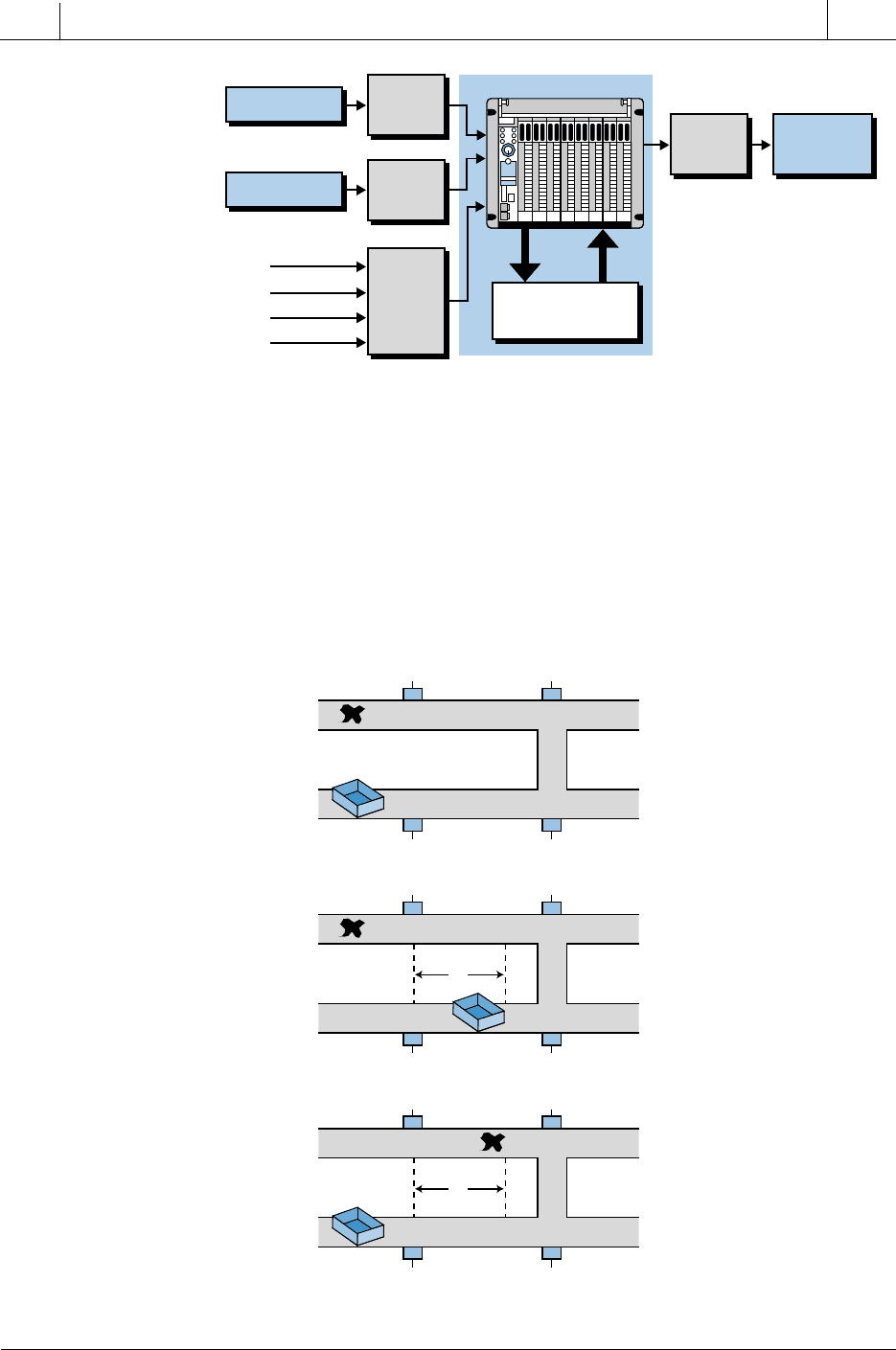
829
CHAPTER
17
Fuzzy
Logic
SECTION
5
Advanced PLC
Topics and Networks
Industrial Text & Video Company 1-800-752-8398
www.industrialtext.com
main program must adjust the two fuzzy inputs, the part/box offset and the rate
of change of the offset, so that the data is centered around a value of 2048
counts. The reason for this is that the range of the fuzzy set will be 0 to 4095
analog counts; the count value of 2048 is the middle membership function.
If a box is present at PE3 and a part is present at PE1, conveyor B should run
at the same speed as conveyor A (the reference speed set initially by the
operator). If the box is at PE3 but the part is behind PE1 (see Figure 17-47),
Figure 17-46. Block diagram of the PLC system.
Encoder 1
Analog
Input
Analog
Input
Discrete
Inputs
PE1
PE2
PE3
PE4
Encoder 1
Analog
Output
Conveyor B
Motor
PLC
Fuzzy Logic
Controller
Figure 17-47. Conveyor B may slow down or speed up.
Conveyor B (Boxes)
PE1 PE2
PE3 PE4
Part and box are even,
no adjustment in speed.
PE1 PE2
PE3 PE4
Box is ahead of part (box is
faster than part). Box conveyor
must be slowed down.
Part is ahead of box (box is
slower than part). Box conveyor’s
speed must increase.
PE1 PE2
PE3 PE4
distance
X
distance
X
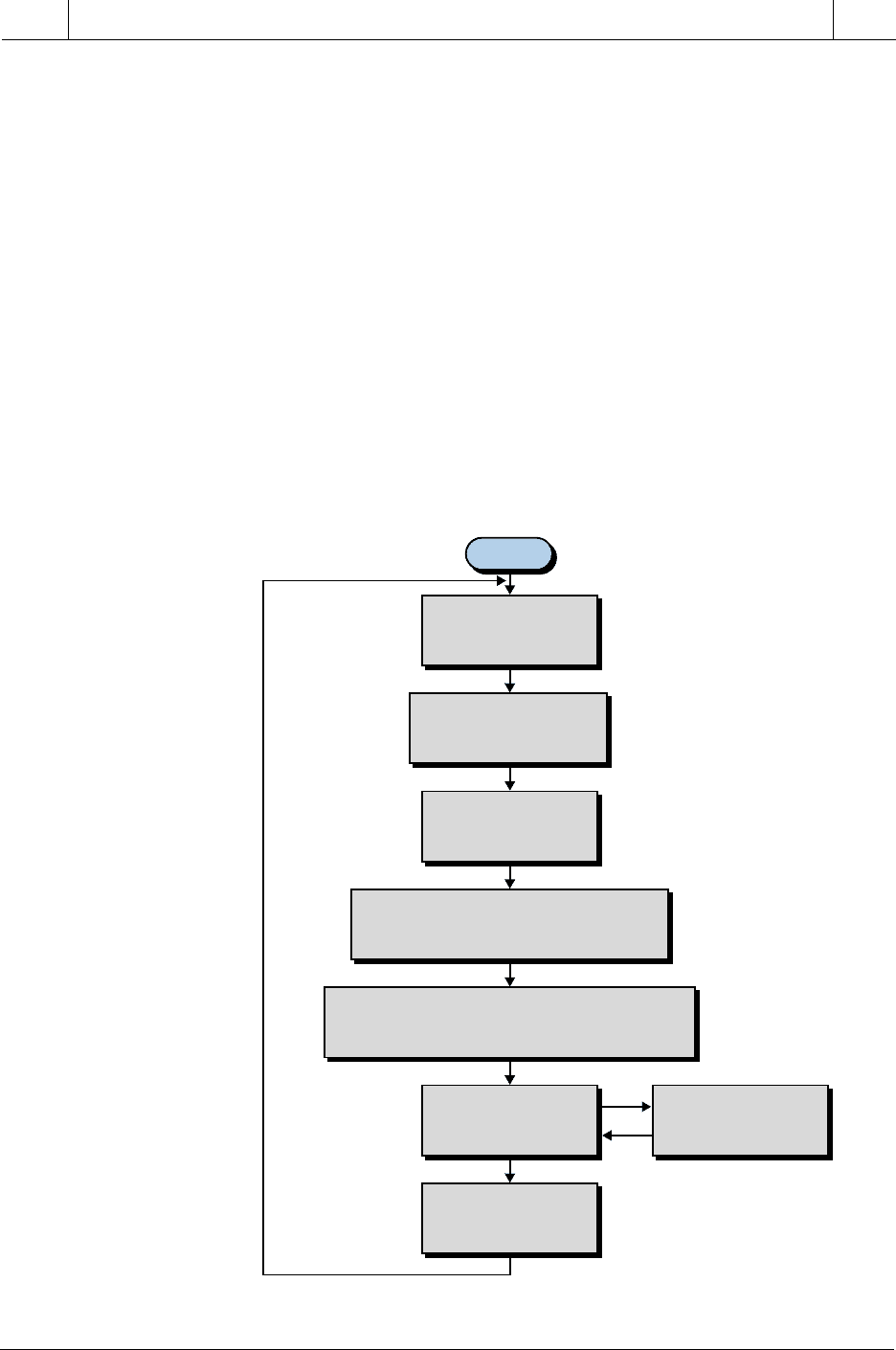
830
SECTION
5
Advanced PLC
Topics and Networks
Industrial Text & Video Company 1-800-752-8398
www.industrialtext.com
CHAPTER
17
Fuzzy
Logic
Figure 17-48. Fuzzy system flowchart.
the system will slow conveyor B until the part is at PE1, at which time the
fuzzy controller will indicate an increase in the speed of conveyor B so that
it will catch up with conveyor A. The distance traveled by the box is
calculated, using the input data from encoder 2, as the difference between the
time the box passes PE3 and the time part passes PE1.
Figure 17-48 shows a flowchart of the steps that must occur to pass correct
input information to the fuzzy processor. The value at position X provides the
part/box offset data. This value is calculated as:
X =−()()Encoder 1counts Encoder 2 counts
The rate of change of the offset is calculated as the difference between the
current offset reading (X
n
) and the previous one (X
(n – 1)
):
∆XX X
nn
=−
−()1
Start
Input conveyor A
reference speed
(encoder 1)
Start timing as parts
and boxes pass
through PE1 and PE3
Determine position
deviation from
encoders 1 and 2
Determine travel distance as the
difference between conveyor A (parts)
and conveyor B (boxes)
Determine the rate of change by
obtaining the difference between the current
position and the previous one
Execute
fuzzy logic
inferencing
(a) Fuzzification
(b) Rule execution
(c) Defuzzification
Output value
to motor via
analog output

831
CHAPTER
17
Fuzzy
Logic
SECTION
5
Advanced PLC
Topics and Networks
Industrial Text & Video Company 1-800-752-8398
www.industrialtext.com
MEMBERSHIP FUNCTIONS AND RULE CREATION
Figure 17-49. Three fuzzy sets used for the conveyor example: (a) deviation between
part and box (input), (b) rate of change of deviation (input), and (c)
speed of conveyor B (output).
–24 inches +24 inches
0
0 counts 4095 counts
2048 counts
1
0
Grade
NSNL ZR PS PL
Box
ahead
Box just
ahead
Part just
ahead
Box and part
about even
Part
ahead
deviation
between
part and box
X
(a)
–10 in/sec +10 in/sec
0
0 counts 4095 counts
2048 counts
1
0
Grade
NSNL ZR PS PL
Box is
slower
Box is a
little slower
Box is a
little faster
Part and box
about even
Box is
faster
rate of
change
of deviation
∆
X
(b)
–10 in/sec
0 counts
+10 in/sec
4095 counts
Grade
NM NS ZR PS PM PL
1
0
NL
Slow
box
Slow
box
a little
No change Speed
box
a little
Speed
box
Speed
box
a lot
Slow
box
a lot
0
2048 counts
speed of
conveyor B
S
(c)
To provide enhanced resolution and accuracy, this system uses a five–
membership function (five-label) fuzzy sets for the two inputs and a seven–
membership function fuzzy set for the output. Figure 17-49 shows these three
fuzzy sets. The offset input is named X (deviation between part and box) and
the offset rate of change input is named
∆
X (rate of change of deviation). The
fuzzy set for the output is named S (speed), which corresponds to the motor
speed of conveyor B. Note that the range of each fuzzy input and output

832
SECTION
5
Advanced PLC
Topics and Networks
Industrial Text & Video Company 1-800-752-8398
www.industrialtext.com
CHAPTER
17
Fuzzy
Logic
Figure 17-50. Fuzzy logic rule matrix.
Table 17-2. Fuzzy system rules.
variable is from 0 to 4095 counts. This corresponds to a range of ±24 inches
for the deviation between the part and box positions, a range of ±10 inches/
second for the rate of change of the offset, and a range of ±10 inches/second
for the speed of the box conveyor.
The fuzzy logic database for this system contains 25 rules. Figure 17-50
shows a matrix of the rules, describing the desired output according to the
deviation between the part and the box and the rate of change of deviation.
This matrix includes a description of the rule inputs and outputs, as well as
their respective membership function labels. Table 17-2 lists the actual rules
that will be entered into the fuzzy controller in IF…THEN form.
Slow the box
Slow the box
Slow the box
a lot
Slow the box
a lot
Slow the box
a little
Slow the box
a little
Slow the box
Slow the box
a lot
Speed up
the box
Speed up
the box a little
Speed up
the box a little
Speed up
the box a little
Speed up
the box a lot
Speed up
the box
Speed up
the box
Speed up
the box
Speed up the
box a little
No change
Slow the box
a little
Slow the box
a little
Deviation
Rate
∆
X
X
Box is slower
NL
Box is
ahead
Box is a little
slower
About even
Box is a little
faster
Box is faster
NS
Box is just
ahead
PS
Part is just
ahead
PL
Part is ahead
ZR
About even
NM NS PM PLPS
NM NS PM PLPS
NM NS PS PMZR
NL NM PS PMNS
NL NL PS PMNS
NL
NS
ZR
PS
PL
Slow the box Slow the box
a little
Speed up
the box
Speed up
the box a lot
Speed up the
box a little
seluRmetsySroyevnoC
1 FI
X
DNALN= ∆
X
NEHTLN=
S
MN= 41 FI
X
DNARZ= ∆
X
NEHTSP=
S
SN=
2 FI
X
DNALN= ∆
X
NEHTSN=
S
MN= 51 FI
X
DNARZ= ∆
X
NEHTLP=
S
SN=
3 FI
X
DNALN= ∆
X
NEHTRZ=
S
MN= 61 FI
X
DNASP= ∆
X
NEHTLN=
S
MP=
4 FI
X
DNALN= ∆
X
NEHTSP=
S
LN= 71 FI
X
DNASP= ∆
X
NEHTSN=
S
MP=
5 FI
X
DNALN= ∆
X
NEHTLP=
S
LN= 81 FI
X
DNASP= ∆
X
NEHTRZ=
S
SP=
6 FI
X
DNASN= ∆
X
NEHTLN=
S
SN= 91 FI
X
DNASP= ∆
X
NEHTSP=
S
SP=
7 FI
X
DNASN= ∆
X
NEHTSN=
S
SN= 02 FI
X
DNASP= ∆
X
NEHTLP=
S
SP=
8 FI
X
DNASN= ∆
X
NEHTRZ=
S
SN= 12 FI
X
DNALP= ∆
X
NEHTLN=
S
LP=
9 FI
X
DNASN= ∆
X
NEHTSP=
S
MN= 22 FI
X
DNALP= ∆
X
NEHTSN=
S
LP=
01 FI
X
DNASN= ∆
X
NEHTLP=
S
LN= 32 FI
X
DNALP= ∆
X
NEHTRZ=
S
MP=
11 FI
X
DNARZ= ∆
X
NEHTLN=
S
SP= 42 FI
X
DNALP= ∆
X
NEHTSP=
S
MP=
21 FI
X
DNARZ= ∆
X
NEHTSN=
S
SP= 52 FI
X
DNALP= ∆
X
NEHTLP=
S
MP=
31 FI
X
DNARZ= ∆
X
NEHTRZ=
S
RZ=

833
CHAPTER
17
Fuzzy
Logic
SECTION
5
Advanced PLC
Topics and Networks
Industrial Text & Video Company 1-800-752-8398
www.industrialtext.com
Once the fuzzy controller receives the inputs, it will determine the final
output value based on a logical addition of the selected outcomes. The
outcome calculation may be very complex, due to the large number of rules.
Remember, however, that the entire fuzzy logic analysis—fuzzification, rule
execution, and defuzzification—is based on user-specified criteria for de-
sired outputs based on photoelectric and encoder input data.
Figure 17-51. Part/box input membership functions.
–24 inches +24 inches
0
0 counts 4095 counts
2048 counts
1
0.75
0.25
0
Grade
NSNL ZR PS PL
Box
ahead
Box just
ahead
Part just
ahead
Box and part
about even
Part
ahead
deviation
between
part and box
X
:
(input)
–10 in/sec +10 in/sec
0
0 counts 4095 counts
2048 counts
1
0.75
0.25
0
Grade
NSNL ZR PS PL
rate of change
of deviation
∆
X
:
(input)
Input Data
X
= 9 inches
Input Data ∆
X
= –3.75 inches
Box is
slower
Box is a
little slower
Box is a
little faster
Part and box
about even
Box is
faster
EXAMPLE 17-5
Figure 17-51 illustrates the part/box input membership functions for a
conveyor system with two input readings, where the deviation be-
tween the part and the box is 9 inches and the rate of change is about
–3.75 inches per second. This means that the part is just ahead of the
box because the box is a little slower than the part. Figure 17-52
illustrates this situation.
(a) Determine which rules are triggered, indicate which outcomes are
selected, and plot the output membership functions. (b) Illustrate the
logical sum of the selected outputs and indicate an approximate
output using the center of gravity method.

834
SECTION
5
Advanced PLC
Topics and Networks
Industrial Text & Video Company 1-800-752-8398
www.industrialtext.com
CHAPTER
17
Fuzzy
Logic
Figure 17-52. Part/box configuration.
SOLUTION
(a) Figure 17-53 shows the four rules that will be triggered by the input
reading, along with the selected outcomes and their graphical repre-
sentation. Note that the outcomes selected are the lowest of the two
possible outcomes due to the AND logical link. Note that two of the
rules generate a 0.25PS output. The bold line in Figure 17-53b
indicates the sum of both outputs (0.25PS
× 2 = 0.5PS).
Figure 17-53. (a) Triggered rules and (b) their output graphic.
PE3 PE4
PE1 PE2
Conveyor A
Conveyor B
9"
IF
X
= ZR AND ∆
X
= ZR THEN
S
= ZR 0.25ZR
0.25 due to
X
0.25 due to ∆
X
IF
X
= ZR AND ∆
X
= NS THEN
S
= PS 0.25PS
0.25 due to
X
0.75 due to ∆
X
IF
X
= PS AND ∆
X
= ZR THEN
S
= PS 0.25PS
0.75 due to
X
0.25 due to ∆
X
IF
X
= PS AND ∆
X
= NS THEN
S
= PM 0.75PM
0.75 due to
X
0.75 due to ∆
X
Outcomes Selected
–10 in/sec
0 counts
+10 in/sec
4095 counts
Grade
NM NS ZR PS PM PL
1
0.75
0
NL
Slow
box
Slow
box
a little
No change Speed
box
a little
Speed
box
Speed
box
a lot
Slow
box
a lot
0
2048 counts
speed of
conveyor B
S
:
0.25
Sum of two
0.25PS
outcomes
(a)
(b)
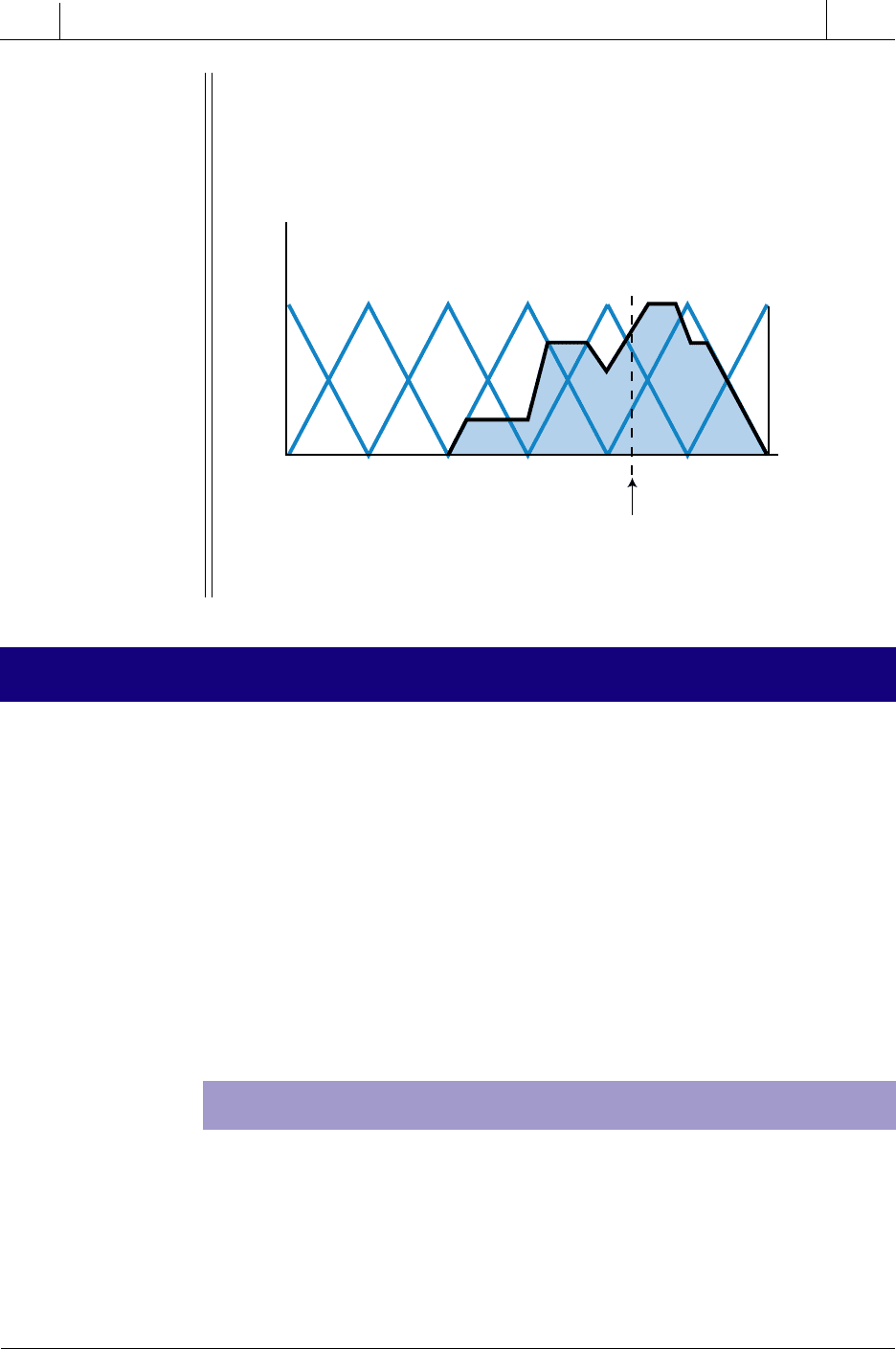
835
CHAPTER
17
Fuzzy
Logic
SECTION
5
Advanced PLC
Topics and Networks
Industrial Text & Video Company 1-800-752-8398
www.industrialtext.com
(b) Figure 17-54 shows the logical sum of all the rules’ actions. The
centroid for this output is located at approximately 2990 counts, which
increases the conveyor speed approximately 4.6 inches/second, so
that the box can catch up with the part.
Figure 17-54. Logical sum of the rules’ actions and the corresponding centroid.
17-6 FUZZY LOGIC DESIGN GUIDELINES
The guidelines presented in this section provide you with the proper proce-
dures for designing an effective fuzzy logic control system. Although some
of these design guidelines are similar to those used in standard PLC systems,
others are design requirements that are specific to fuzzy logic systems. The
basic elements for the successful implementation of a fuzzy logic control
system include:
• control objectives
• control system configuration
• input/output determination
• fuzzy inference engine design
CONTROL OBJECTIVES
Fuzzy logic can be applied to virtually any type of control system, but it is
especially suited for applications that rely heavily on human intuition and
experience. The primary objective of applying fuzzy logic to an existing
process is to improve the overall process and to automate tasks that previously
required human judgment. In a new system, the primary objective of using
fuzzy logic is usually to implement control that cannot be implemented
–10 in/sec
0 counts
+10 in/sec
4095 counts
Grade
NM NS ZR PS PM PL
1
0
NL
Slow
box
Slow
box
a little
No change Speed
box
a little
Speed
box
Speed
box
a lot
Slow
box
a lot
0
2048 counts
speed of
conveyor B
S
(output)
Centroid = 2990 counts
(approx. +4.6 in/sec)
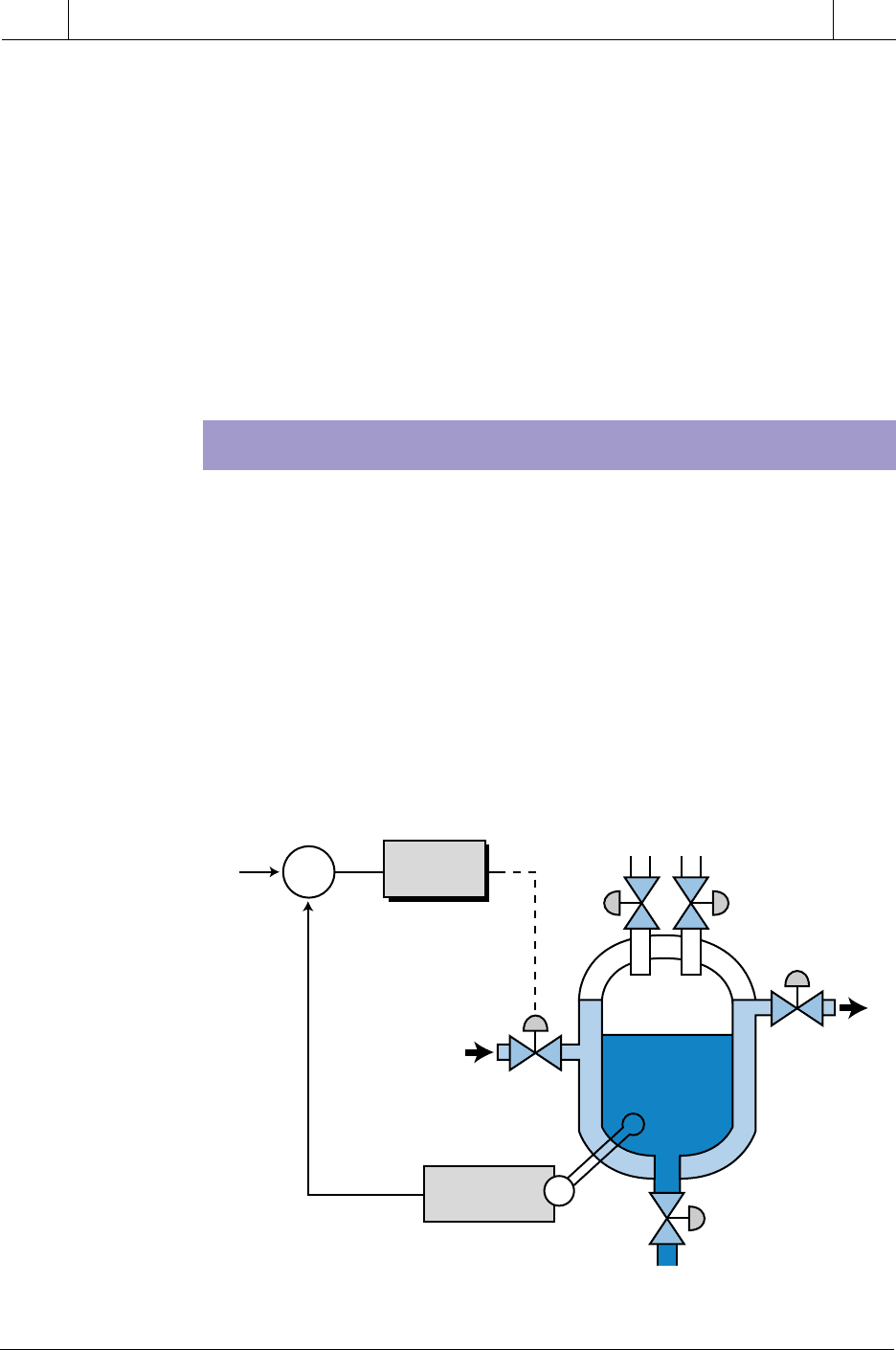
836
SECTION
5
Advanced PLC
Topics and Networks
Industrial Text & Video Company 1-800-752-8398
www.industrialtext.com
CHAPTER
17
Fuzzy
Logic
using standard control methods. A system designer should not use fuzzy
logic control just because it is available. Rather, he or she should use it
because it will enhance the system. Otherwise, the outcome may not be
enhanced; it may just become confusing.
Typical applications of fuzzy logic involve batching systems and temperature
control loops, where process control involves “tweaking” the output based on
judgments about input conditions. For example, a temperature control loop
application typically requires a knowledgeable operator who can regulate the
control element based on decisions such as “if the temperature is a little high
but all other inputs are OK, then turn the steam valve a little clockwise.” This
rationale lends itself to fuzzy logic control.
CONTROL SYSTEM CONFIGURATION
The control objective may lead you to one of several types of system
configurations where fuzzy logic can be implemented. Fuzzy logic does not
have to be applied only in dedicated fuzzy control applications. It can also be
used as a complementary system that supports other more conventional
control methods. When used in this manner, the system is said to be a
conventional, fuzzy, hybrid control system.
Figure 17-55 illustrates a typical process control system controlled by a
PID loop. A fuzzy logic controller could enhance this PID system by
regulating the steam volume based on the tank jacket temperature and the
batch temperature (see Figure 17-56). If the jacket temperature decreases
SP
PV
+
–
Σ
Steam
Temperature
Transmitter
Steam
Return
Batch
Temperature
PID
Controller
Figure 17-55. PID-controlled heating system.

837
CHAPTER
17
Fuzzy
Logic
SECTION
5
Advanced PLC
Topics and Networks
Industrial Text & Video Company 1-800-752-8398
www.industrialtext.com
before the batch temperature, the fuzzy controller can take corrective action
by suggesting an increase in the steam volume going into the jacket. This
operation is similar to cascade control utilizing a fuzzy controller for the
inner loop (secondary loop). The fuzzy controller’s responsibility is to
maintain a proper ratio between the jacket and batch temperatures. Figure
17-57 illustrates several other fuzzy logic system block diagrams, including
a pure fuzzy control system.
SP
PV
+
–
Σ
Steam
Temperature
Transmitter
Batch Temperature
Jacket
Temperature
PID
Controller
Fuzzy
Controller
Temperature
Transmitter
Figure 17-56. PID-controlled heating system with a fuzzy logic controller.
INPUT/OUTPUT DETERMINATION
Once you have selected the fuzzy system configuration that is appropriate for
the control objective, you must determine which inputs and outputs will be
used in the fuzzy logic controller. The input conditions, or fuzzy input
variables, must be able to be expressed by IF…THEN statements. That is,
the input conditions to the fuzzy controller must be able to trigger conditional
rules, meaning that they specify one or more output conditions. Inputs
should be selected according to the process situations they describe. In other
words, if you select two inputs that have little to do with each other, the
outcomes that they generate will not be as precise or intuitive as the outcomes
generated by inputs that deal with the same process element. For example,
referring to Figure 17-56, the batch temperature and jacket temperature both
relate to the regulation of the steam valve output. By analyzing these two
inputs together, the fuzzy controller can make a precise decision about how
much to adjust the steam valve. An analysis of two other unrelated inputs,
such as batch temperature and liquid level, would not provide such an
informed decision.
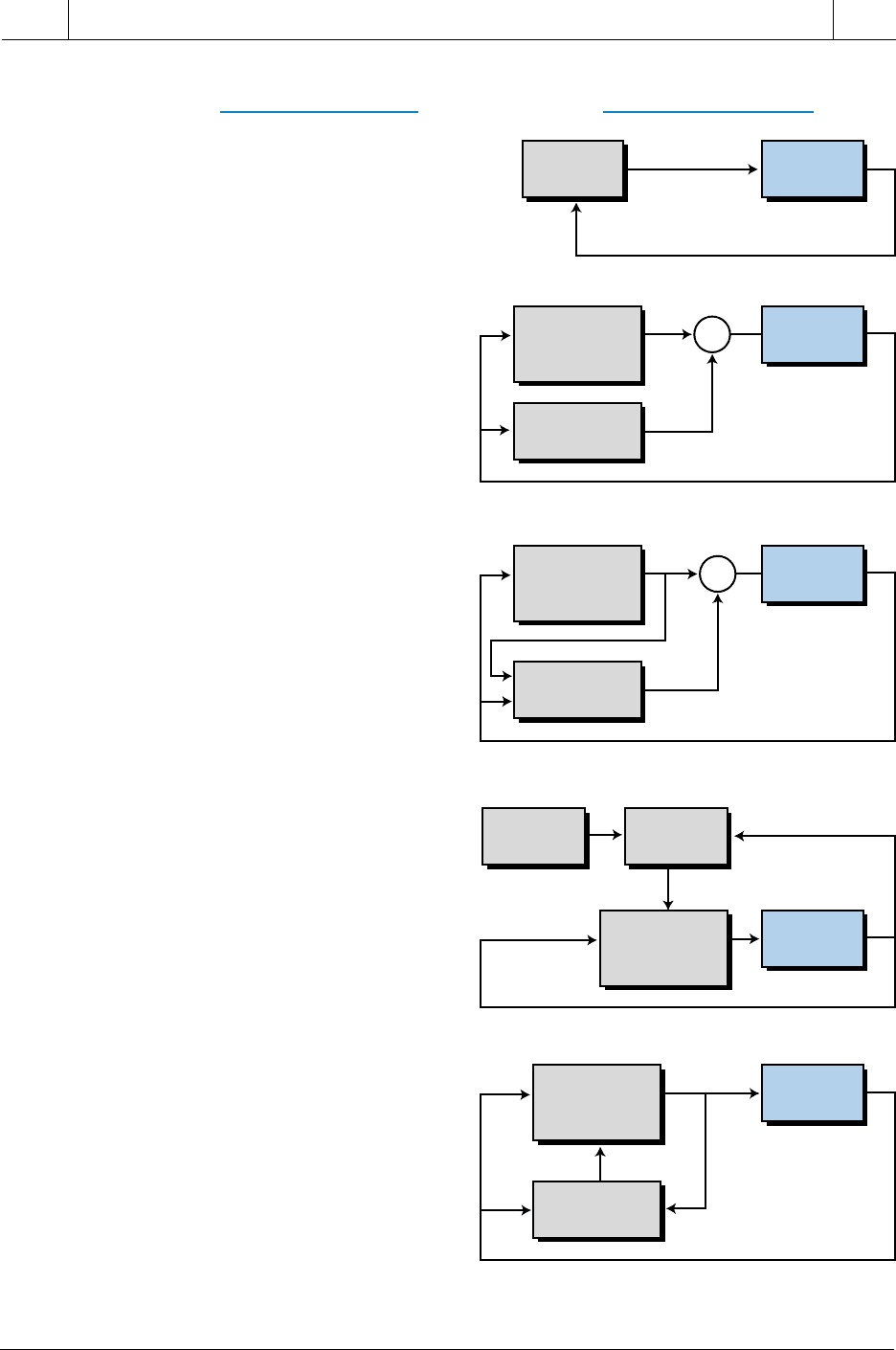
838
SECTION
5
Advanced PLC
Topics and Networks
Industrial Text & Video Company 1-800-752-8398
www.industrialtext.com
CHAPTER
17
Fuzzy
Logic
Fuzzy
Controller
Process
Fuzzy Logic System System Block Diagram
Pure Fuzzy Control
Existing
Conventional
Controller
Process
Parallel Fuzzy Control
Fuzzy
Controller
Existing
Conventional
Controller
Process
Fuzzy
Controller
Fuzzy Logic—Refined Control
(Modified with fuzzy logic)
Existing
Conventional
Controller
Process
Fuzzy
Controller
Fuzzy Logic—Tuned Control
Existing
Conventional
Controller
Fuzzy
Controller
Operator
Process
Man-Machine Fuzzy Interface
Settings
Tuning
Figure 17-57. Various types of fuzzy logic systems and their block diagrams.
